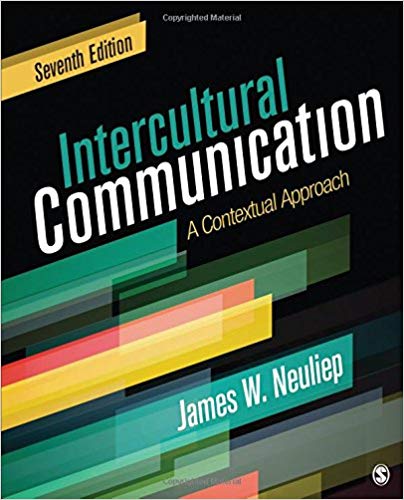In Stock
Test Bank For Intercultural Communication A Contextual Approach 7th Edition by James W. Neuliep
Digital item No Waiting Time Instant DownloadISBN: 9781506315133Edition 7th EditionVersion US EditionAuthor NeuliepRelease Date 2017Publisher SAGE
Original price was: $95.00.$45.00Current price is: $45.00.
Test Bank For Intercultural Communication A Contextual Approach 7th Edition by James W. Neuliep
Instructor Resources Neuliep, Intercultural Communication, 7e SAGE Publishing, 2018
Chapter 1: The Necessity of Intercultural CommunicationMultiple Choice1. Communicating and establishing relationships with people from different cultures can lead to a number of benefits, including healthier communities, increased commerce, reduced conflict, and ______.a. personal growth through toleranceb. reduced illegal immigrationc. increased legal immigrationd. increased agenda-setting opportunitiesAns: AAnswer Location: Benefits of Intercultural CommunicationLearning Objective: 1-1: Describe why intercultural communication is a necessity. Cognitive Domain: KnowledgeDifficulty Level: Easy2. Who is generally recognized as the founder of the academic discipline we call intercultural communication?a. Edward T. Hallb. James W. Neuliepc. James C. McCroskeyd. Arthur M. SchlesingerAns: AAnswer Location: The Study of Intercultural CommunicationLearning Objective: 1-4: Explain the different contexts that make up the contextual model of intercultural communication.Cognitive Domain: Knowledge Difficulty Level: Easy3. Communication is considered a process because ______. a. it is contextualb. it is always developingc. it frequently stops and startsd. it is verbal and nonverbalAns: BAnswer Location: The Nature of Human CommunicationLearning Objective: 1-2: Define and discuss the nature of communication. Cognitive Domain: ComprehensionDifficulty Level: Medium
Instructor Resources Neuliep, Intercultural Communication, 7e SAGE Publishing, 20184. Communication is considered interactive and transactive because ______. a. it occurs between peopleb. it is multidimensionalc. it is intrapersonald. it is flexible and adaptiveAns: AAnswer Location: The Nature of Human CommunicationLearning Objective: 1-2: Define and discuss the nature of communication. Cognitive Domain: KnowledgeDifficulty Level: Easy5. A symbol can be defined as ______.a. a natural part of that which it representsb. a decoded message presenting something elsec. an arbitrarily selected and learned stimulus representing something else d. an encoded message representing something elseAns: CAnswer Location: The Nature of Human CommunicationLearning Objective: 1-2: Define and discuss the nature of communication. Cognitive Domain: KnowledgeDifficulty Level: Easy6. Intentional communication occurs when ______.a. two or more people perceive each otherb. two or more people consciously engage in interaction with each otherc. two or more people create nonverbal symbols representing something else d. two or more people use language to create symbolsAns: BAnswer Location: The Nature of Human CommunicationLearning Objective: 1-2: Define and discuss the nature of communication Cognitive Domain: KnowledgeDifficulty Level: Easy7. There are at least five different contexts that influence intercultural communication, including the cultural context, the microcultural context, the environmental context, the sociorelational context, and the ______.a. perceptual contextb. historical context c. personal context d. situational context Ans: ALearning Objective: 1-4: Explain the different contexts that make up the contextual model of intercultural communication.Cognitive Domain: KnowledgeDifficulty Level: Easy
Instructor Resources Neuliep, Intercultural Communication, 7e SAGE Publishing, 20188. Culture can be defined as an accumulated pattern of ______. a. contexts, situations, and environmentsb. processes, dynamics, and intentionsc. languages, schools, and lawsd. values, beliefs, and behaviorsAns: DAnswer Location: A Contextual Model of Intercultural CommunicationLearning Objective: 1-4: Explain the different contexts that make up the contextual model of intercultural communication.Cognitive Domain: KnowledgeDifficulty Level: Easy9. The verbal and nonverbal symbols with which members of a culture communicate are ______. a. taught informallyb. shared universallyc. culture-boundd. universally expressedAns: CAnswer Location: Verbal and Nonverbal Symbol Systems Learning Objective: 1-3: Define and discuss the nature of culture. Cognitive Domain: KnowledgeDifficulty Level: Easy10. The environmental context in the model of intercultural communication includes the ______. a. intrinsic and extrinsic cultural contextb. the intimate sociorelationships that people develop in the culturec. the physical geography, architecture, landscape and climate of the cultured. the landmark institutions of a culture (e.g., schools, malls, ballparks)Ans: CAnswer Location: A Contextual Model of Intercultural CommunicationLearning Objective: 1-4: Explain the different contexts that make up the contextual model of intercultural communication.Cognitive Domain: Knowledge Difficulty Level: Easy

Reviews
There are no reviews yet.